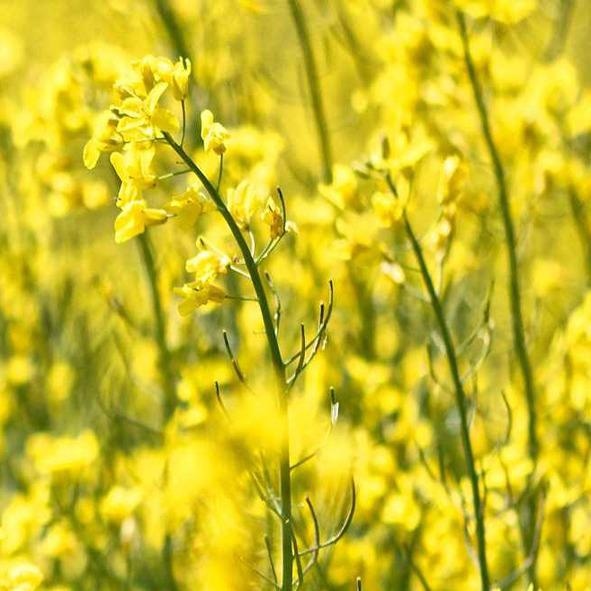Mar 2 2021
Proteins, similar to fats, lignin and cellulose, are renewable raw materials but their potential for the chemical sector has not been fully explored.
 Rapeseed field in bloom: Rapeseed is the most widely grown oilseed in Germany–it ranks third worldwide after oil palm and soy. Image Credit: © Alexas_Fotos/pixabay.com.
Rapeseed field in bloom: Rapeseed is the most widely grown oilseed in Germany–it ranks third worldwide after oil palm and soy. Image Credit: © Alexas_Fotos/pixabay.com.
Now, research teams from the Fraunhofer Institute for Process Engineering and Packaging IVV have teamed up with associates to change all this; the concept is to apply the potential techno-functional characteristics of vegetable proteins for industrial use. The goal of the TeFuProt project is to migrate from petroleum and use more renewable raw materials.
While proteins obtained from vegetable sources were playing a major role in the chemical sector a century ago, as an adhesive or a binding agent for instance, their applications have reduced since the development of the petrochemical sector.
The associates involved in the TeFuProt project, which stands for techno-functional protein, are striving to change all this and hoping to obtain proteins from agricultural waste products for industrial use.
The objective of this bioeconomy plan is to offset the long-term price increase and scarcity of fossil raw materials and utilize renewal raw materials as a substitute to petroleum.
Rapeseed as a Source of Protein
The processing of agricultural raw materials, like rapeseed, leads to huge amounts of protein. Such proteins are a byproduct of the recovery of rapeseed oil—a process in which oil is pressed out of the seed. Following this, protein-containing byproducts—the supposed rapeseed press-cake and rapeseed meal—are left behind.
Up until now, this residue has been used mainly as a foodstuff in livestock farming. But this usage is limited because of the bitter substances contained.
Andreas Fetzer, Scientist, Fraunhofer Institute for Process Engineering and Packaging IVV
The protein fractions of the rapeseed press-cake have several functional properties, like the potential to form films, gels and foams, and also their ability to retain water; hence, they have a large potential for an array of technical applications.
Protein fractions can ideally be used as additives for paints, lubricants, adhesives, varnishes, polymers, detergents and building materials.
The vegetable proteins are opening the door to the development of novel, sustainable, bio-based products with improved properties.
Andreas Fetzer, Scientist, Fraunhofer Institute for Process Engineering and Packaging IVV
And this strategy also decreases humans’ reliance on fossil resources and advances climate-friendly production.
At the Fraunhofer Institute for Process Engineering and Packaging IVV, scientists were tasked to explore the means to separate the proteins from the rape-seed press-cake and the rapeseed meal to design the processes needed.
The team was also in charge of the pre-formulation and modification of proteins in such a way that they can be transported, either in the form of a liquid solution or in dried powders, to the development partners for additional tests.
The researchers also examined the techno-functional properties, like foaming, solubility, and emulsifying behavior, and even film-forming properties.
Apart from the Fraunhofer Institute for Process Engineering and Packaging IVV, ANiMOX GmbH and Naturstoff-Technik GmbH (2014-2017) were also tasked with synthesizing and refining the protein.
Alternative Binding Agents in Paints and Varnishes
Particularly, the film-forming properties yielded convincing test results.
Upon drying proteins dissolved in water, to which a bio-based plasticizer was added, in a petri dish, the water evaporates and the proteins cross-link to form a stable film. Thus, proteins are principally suitable as alternative binding agents in paints and varnishes, wood stains or parquet coatings which usually contain petroleum-based raw materials. Acrylates, for example, can be replaced by protein preparations.
Andreas Fetzer, Scientist, Fraunhofer Institute for Process Engineering and Packaging IVV
The proteins also have the potential to act as barriers or efficiently bind colorants. This demonstrated the additional benefit of the protein-based coating, particularly in the wood industry—the colorants were successfully inhibited from 'bleeding' out of the wood.
Along with his collaborators, Fetzer effectively recovered four kinds of protein via four dis-clearly different processes.
“We de-oil, grind and dissolve the rapeseed press-cake in water. The mixture is then centrifuged to separate the solids from the liquids. After that, we refine the aqueous extract with the dissolved proteins”, added the researcher explaining the process sequence. The recovered protein isolates usually have a protein content of more than 90%.
Chance to Create Breakthrough Innovations
The long-term experiment of the 18 partners in total resulted in a range of potential products, a few of which are already available as models.
These models comprise biodegradable films as a kind of packaging material for detergent packets, for instance, as a fiberboard from production residues, as plant coverings and also as binding agents altered with rapeseed protein.
The list of novel solutions is completed by molded foams for packaging or flame-retardant insulating foams for the construction sector, thickening components for binders or lubricants for lubricating lacquers, fiber protection and dye transfer inhibitors in environmentally friendly laundry detergents, and additives in universal cleaning agents meant for wood surfaces.
“In many cases, we have successfully integrated the proteins into the products and generated properties with added value,” concluded the researcher.
The following steps it to improve the preparations and get them ready for the market. The long-term goal of the associates is to substitute petrochemical-based products with bio-based alternatives on an industrial scale and produce added value via the use of vegetable proteins.